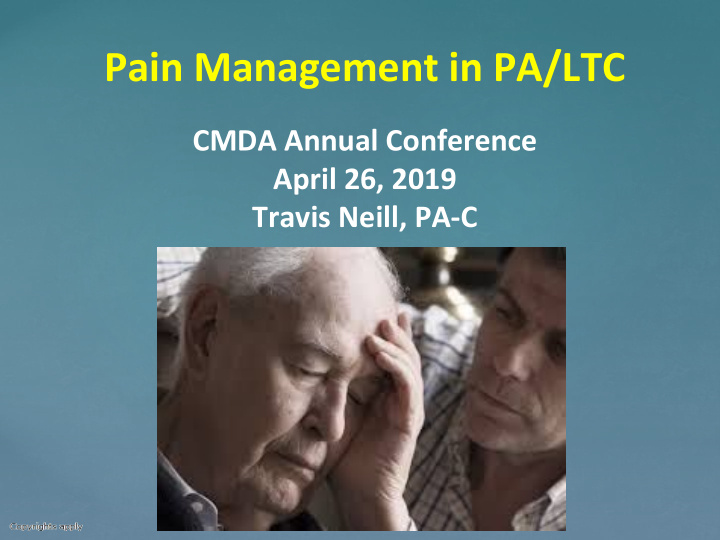



Pain Management in PA/LTC CMDA Annual Conference April 26, 2019 Travis Neill, PA-C
Financial Disclosures
Prevalence of Pain in LTC ● Pain prevalence is difficult to assess but based on 6 studies of self-reported and chart reviews the range was 49% to 83% of Nursing Home residents ● 40% of Cancer patients discharged to a Nursing Home reported daily pain ● The prevalence of analgesic use ranges from 27% to 44% suggesting a lot of pain is being under treated
Consequences of untreated or undertreated pain ● Reduced function(ADLs) and in turn increased staffing needs ● Depression, Anxiety, Poor sleep, Malnutrition ● Post-surgical or wound patients with untreated pain can lead to chronic pain or hyperalgesia ● There is a strong psychological component where untreated pain can lead to negative perceptions making the pain much harder to treat
What is Pain? ● Pain is an unpleasant sensory and emotional experience that is highly individualized ● Pain is not a simple sensation, but rather a complex experience, only a part of which is sensory in nature ● Nociception is the sensory nervous system's response to certain harmful or potentially harmful stimuli
The Body’s Response to Pain
The Body’s Response to Pain ● The body responds to pain through numerous and interconnected physiological processes via the sympathetic nervous system (SNS), neuro-endocrine system and immune system, but also via emotions ● Sweating, nausea, tachycardia, hypertension, water retention, increased need for oxygen, increased risk of infection, increased blood glucose, urinary freq or incont, pallor, anxiety, fear, depression ● The anticipation or perception of pain can also initiate this response and untreated pain can become chronic neural pathways and contribute to disease
Transmission, Modulation, Perception 1. Transmission - the nerve impulse travels from the site of transduction to the brain in three stages: from nociceptors to spinal cord, from spinal cord to brain stem, and from brain stem to other parts of the brain 2. Modulation - pain is reduced or increased by the body through descending (from brain to spinal cord) and ascending (from spinal cord to brain) mechanisms 3. Perception - when pain becomes a conscious experience, involves recognising, defining and responding to pain. It takes place in the cortex, the limbic system, and the reticular system.
• Local Anesthetics • NSAIDs • Topicals • Opioids • Neuroleptics • Tylenol • Corticosteroids/Injections • Muscle Relaxers Pharmacological • Antihistamines • Nerve blocks Interventions • Massage therapy • Physical & • Aromatherapy Occupational Therapy • Acupuncture • Biofeedback • TENS units • Exercise Non-pharm • Ice machines/Heat Interventions
Perception Modalities ● Relaxation Techniques - meditation, guided imagery ● Antidepressants ● Counseling - therapist, pastoral support ● Social Support - family or peer support groups ● Placebo effect - emphasize certain modalities ● Distraction and reframing ● Exercise - movement is your friend ● Emotional Intelligence - providers and staff ● Physical and Occupational Therapy
Challenges to Assessing Pain in LTC ● MDS done quarterly with inconsistent assessments in between ● Evaluating non-verbal signs of pain ● Cognitive, Communication and Cultural Barriers ● Staff turnover, training and access to tools ● Fear of addiction, shame ● Staff bias ● How much time is spent on Perception modalities?
Management of Pain in LTC Interventions should be: ● preceded by an assessment - good history from patient or family and standardized assessments ● tailored to acute vs chronic ● individualized with goals discussed and documented ● monitored for effectiveness and/or adverse consequences in frequent intervals ● collaborative - nurses, CNAs, therapists, providers, family, patient
Clinical Practice Guidelines on Pain Management ● American Geriatrics Society ● AMDA - The Society for Post-Acute and Long-Term Care Medicine
Recommend
More recommend